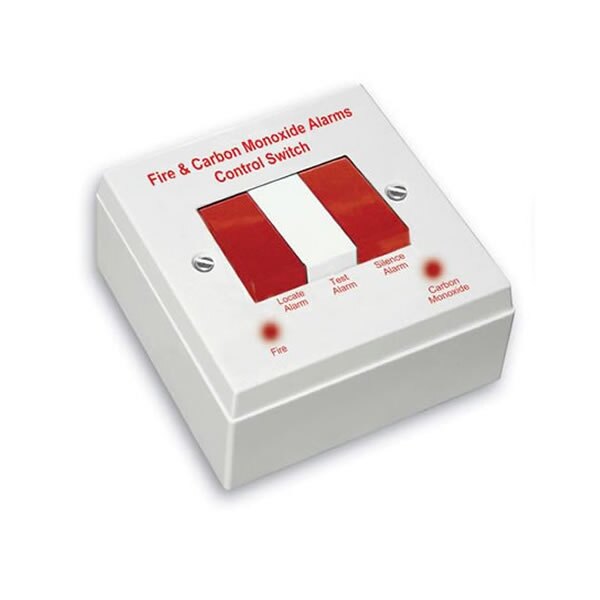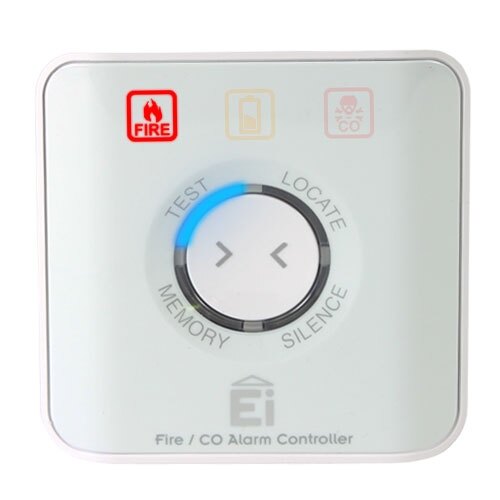-
Contact
Sales & Customer Service
0800 612 6537 support@safelincs.co.uk Live ChatDelivery Enquiries
0800 077 6149 - Resources
Fire & Safety Solutions
CALL OUR TEAM NOW 0800 612 6537
Lines open today 8am - 6pm
Quick Delivery
From £3.19 inc VAT
Live Chat - Online
Instant help & Advice
Trade Discounts
and exclusive pricing
0% Credit Available
Open an account now
5 Star Customer Feedback
Wireless Remote Control Switch with Hush, Locate and Test for Smoke and CO Detection - Ei412
Discontinued Product
This product has been discontinued.
alternative product
Wireless Smoke and CO Alarm Controller - Ei450
- Test, locate, silence and memory function in one location
- Sealed 10 year lithium battery - 10 years life
- Indicates if the alarm source is fire or CO
- Designed to be part of a radio-interlinked smoke and CO alarm system
£80.15 inc VAT
£66.79 ex VAT
Product Overview
Interconnection
Carbon Monoxide Alarms
Technical Data
FAQs (3)
The Ei412 wireless wall mounted remote control switch unit can locate the source of an alarm, silence any false alarms and test all the alarms in the system. The unit works with arrangements including both wireless smoke and wireless CO detectors and has individual LED indicators to identify which type of danger has been detected.
- Battery operated unit
- Fitted with sealed 10 year lithium battery
- 5 year warranty
- No wiring required, battery operated
- The locate option silences all the alarms except the initial activating alarm allowing easy identification of the source of the fire or CO leak
- The test option will activate all the alarms, making regular testing easy
- The hush option will silence any false alarm
- Auto-reset within 10 minutes for locate and hush
- Wireless control of up to 20 smoke alarms
- Must be located within 30m of the nearest smoke alarm
The table below shows all the units that can interconnect with the Ei412 control switch.
Compatible Alarms| Model Number | Type of unit | Type of interconnection |
| Ei605TYCRF | Battery powered optical alarm | Radio-interlinked |
| EI603TYCRF | Battery powered heat alarm | Radio-interlinked |
| Ei168RC/141RC | Mains powered ionisation alarm (Alkaline back up) | Radio-interlinked using the Ei168RC base |
| Ei168RC/146RC | Mains powered optical alarm (Alkaline back up) | Radio-interlinked using the Ei168RC base |
| Ei168RC/144RC | Mains powered heat alarm (Alkaline back up) | Radio-interlinked using the Ei168RC base |
| Ei168RC/Ei161RC | Mains powered ionisation alarm (Lithium back up) | Radio-interlinked using the Ei168RC base |
| Ei168RC/Ei166RC | Mains powered optical alarm (Lithium back up) | Radio-interlinked using the Ei168RC base |
| Ei168RC/Ei164RC | Mains powered heat alarm (Lithium back up) | Radio-interlinked using the Ei168RC base |
| Ei168RC/Ei2110 | Mains powered multi sensor alarm (Lithium back up) | Radio-interlinked using the Ei168RC base |
| Model Number | Type of unit | Type of interconnection |
| Ei208WRF | Battery powered CO detector | Radio-interlinked |
| Ei262 | Mains powered CO detector | Radio-interlinked |
| Product Code | EI412 |
|---|---|
| Brand | EI Electronics |
| Battery Type | Longlife Lithium Battery |
| Dimensions (HxWxD) | 88x88x42mm |
| Weight | 0.22kg |
| Product Datasheets |
Q. What is the difference between Ei605TYCRF and Ei605CRF smoke alarms, can both be used with the EI412 remote control panel?
A.
The Ei605TYCRF comes with a ten year lithium battery, this should last for the life span of the alarm. The Ei605CRF comes with an alkaline battery that will need to be changed every 12 months. As these alarms are part of the Ei600 series they are both compatible with the Ei412.
Q. Can the Ei600RF series be connected with a CO detector?
A.
Yes, the Ei208WRF CO detector is suitable and we recommend that you also install a Ei412 locator switch to allow you to find out if an alarm was caused by CO gas or by a fire.
Q. Can the Ei160 RF series be connected to a CO detector?
A.
Yes, you can use either the battery powered Ei208WRF CO detector or the mains powered Ei262 CO detector. We also recommend that you fit a Ei412 locator switch to allow you to find out if an alarm was caused by CO gas or a fire!
Customer Reviews
1 customer has given this product an overall rating of 5 out of 5
Reviews by real customers
All of our product reviews are written by real customers that have purchased this product from us and are published without modification.Rating: 5 / 5 Stars
Reviewed by:
Delighted, easy to install amd works brilliantly
Published on: 1st May 2015
Looking for more information?
If you have any questions or would like more information about this product you can ask one of our specialists.
Live Chat Available Now
Direct Telephone
01507 464181






















